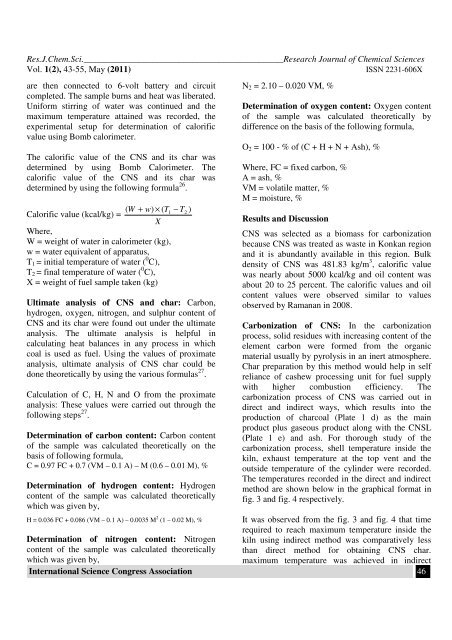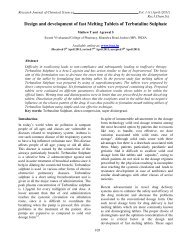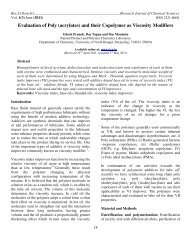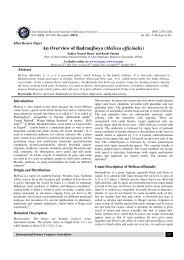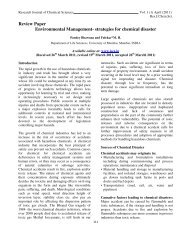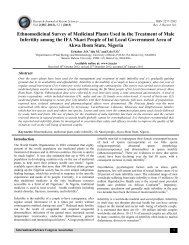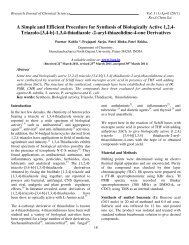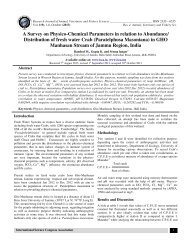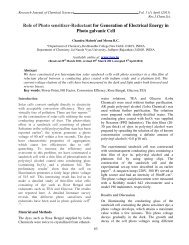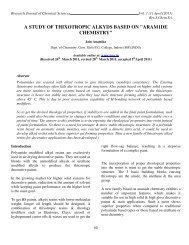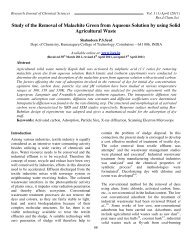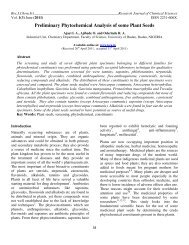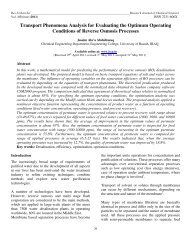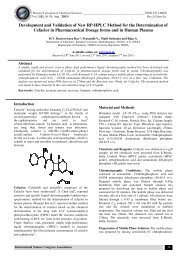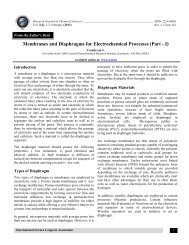Study of Carbonization for Cashew Nut Shell - ISCA
Study of Carbonization for Cashew Nut Shell - ISCA
Study of Carbonization for Cashew Nut Shell - ISCA
You also want an ePaper? Increase the reach of your titles
YUMPU automatically turns print PDFs into web optimized ePapers that Google loves.
Res.J.Chem.Sci._____________________________________________Research Journal <strong>of</strong> Chemical Sciences<br />
Vol. 1(2), 43-55, May (2011) ISSN 2231-606X<br />
are then connected to 6-volt battery and circuit<br />
completed. The sample burns and heat was liberated.<br />
Uni<strong>for</strong>m stirring <strong>of</strong> water was continued and the<br />
maximum temperature attained was recorded, the<br />
experimental setup <strong>for</strong> determination <strong>of</strong> calorific<br />
value using Bomb calorimeter.<br />
The calorific value <strong>of</strong> the CNS and its char was<br />
determined by using Bomb Calorimeter. The<br />
calorific value <strong>of</strong> the CNS and its char was<br />
determined by using the following <strong>for</strong>mula 26 .<br />
( W + w)<br />
× ( T1<br />
− T2<br />
)<br />
Calorific value (kcal/kg) =<br />
X<br />
Where,<br />
W = weight <strong>of</strong> water in calorimeter (kg),<br />
w = water equivalent <strong>of</strong> apparatus,<br />
T1 = initial temperature <strong>of</strong> water ( 0 C),<br />
T2 = final temperature <strong>of</strong> water ( 0 C),<br />
X = weight <strong>of</strong> fuel sample taken (kg)<br />
Ultimate analysis <strong>of</strong> CNS and char: Carbon,<br />
hydrogen, oxygen, nitrogen, and sulphur content <strong>of</strong><br />
CNS and its char were found out under the ultimate<br />
analysis. The ultimate analysis is helpful in<br />
calculating heat balances in any process in which<br />
coal is used as fuel. Using the values <strong>of</strong> proximate<br />
analysis, ultimate analysis <strong>of</strong> CNS char could be<br />
done theoretically by using the various <strong>for</strong>mulas 27 .<br />
Calculation <strong>of</strong> C, H, N and O from the proximate<br />
analysis: These values were carried out through the<br />
following steps 27 .<br />
Determination <strong>of</strong> carbon content: Carbon content<br />
<strong>of</strong> the sample was calculated theoretically on the<br />
basis <strong>of</strong> following <strong>for</strong>mula,<br />
C = 0.97 FC + 0.7 (VM – 0.1 A) – M (0.6 – 0.01 M), %<br />
Determination <strong>of</strong> hydrogen content: Hydrogen<br />
content <strong>of</strong> the sample was calculated theoretically<br />
which was given by,<br />
N2 = 2.10 – 0.020 VM, %<br />
Determination <strong>of</strong> oxygen content: Oxygen content<br />
<strong>of</strong> the sample was calculated theoretically by<br />
difference on the basis <strong>of</strong> the following <strong>for</strong>mula,<br />
O2 = 100 - % <strong>of</strong> (C + H + N + Ash), %<br />
Where, FC = fixed carbon, %<br />
A = ash, %<br />
VM = volatile matter, %<br />
M = moisture, %<br />
Results and Discussion<br />
CNS was selected as a biomass <strong>for</strong> carbonization<br />
because CNS was treated as waste in Konkan region<br />
and it is abundantly available in this region. Bulk<br />
density <strong>of</strong> CNS was 481.83 kg/m 3 , calorific value<br />
was nearly about 5000 kcal/kg and oil content was<br />
about 20 to 25 percent. The calorific values and oil<br />
content values were observed similar to values<br />
observed by Ramanan in 2008.<br />
<strong>Carbonization</strong> <strong>of</strong> CNS: In the carbonization<br />
process, solid residues with increasing content <strong>of</strong> the<br />
element carbon were <strong>for</strong>med from the organic<br />
material usually by pyrolysis in an inert atmosphere.<br />
Char preparation by this method would help in self<br />
reliance <strong>of</strong> cashew processing unit <strong>for</strong> fuel supply<br />
with higher combustion efficiency. The<br />
carbonization process <strong>of</strong> CNS was carried out in<br />
direct and indirect ways, which results into the<br />
production <strong>of</strong> charcoal (Plate 1 d) as the main<br />
product plus gaseous product along with the CNSL<br />
(Plate 1 e) and ash. For thorough study <strong>of</strong> the<br />
carbonization process, shell temperature inside the<br />
kiln, exhaust temperature at the top vent and the<br />
outside temperature <strong>of</strong> the cylinder were recorded.<br />
The temperatures recorded in the direct and indirect<br />
method are shown below in the graphical <strong>for</strong>mat in<br />
fig. 3 and fig. 4 respectively.<br />
H = 0.036 FC + 0.086 (VM – 0.1 A) – 0.0035 M<br />
International Science Congress Association 46<br />
2 (1 – 0.02 M), % It was observed from the fig. 3 and fig. 4 that time<br />
required to reach maximum temperature inside the<br />
Determination <strong>of</strong> nitrogen content: Nitrogen kiln using indirect method was comparatively less<br />
content <strong>of</strong> the sample was calculated theoretically than direct method <strong>for</strong> obtaining CNS char.<br />
which was given by,<br />
maximum temperature was achieved in indirect


